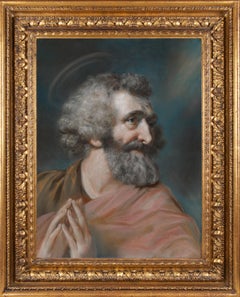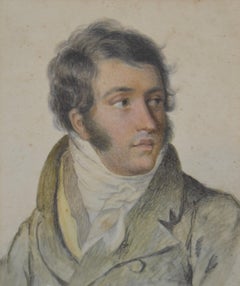John Russell Portrait Drawings and Watercolors
English, 1745-1806
Russell was born in Guildford, Surrey in 1745, his father John Snr was four times the mayor of the town and an artist himself. The young John Russell trained under Francis Cotes RA who was one of the pioneers of English pastel painting. Both he and Cotes were admirers of the celebrated Italian pastel artist Rosalba Carriera, her methods significantly influenced his technique of "sweetening". At 19 and much to the protests of his family & teacher he converted to Methodism. In 1767 he set up his studio in London when he met the notorious Dr. William Dodd, whose portrait he painted in 1768. At this time he had met the Countess of Huntingdon along with many other members of the nobility. In 1770 he married Hannah Faden and moved to Cavendish Square London.
he travelled extensively painting around Britain, in 1770 he entered The Royal Academy of Art and won the the gold medal the same year, he also exhibited at The Society of Artists, he exhibited around 330 works at the Academy between 1769 until his death.
In 1788 he painted a number of important commissions that led to him being appointed as pastel painter to King George III, he also painted Queen Charlotte, the Prince of Wales and the Duke of York. By this time Russell had developed an extensive fashionable & influential clientele.
Russell was a deeply religious man and shunned the dinner circuit of London high society, due to concerns of being exposed to blasphemous conversation. He was however on good terms with Sir Joshua Reynolds with whom he dined with at the Academy, the Dilettanti Society and the Literary Club.
Russell's work can be viewed at many of the prominent galleries in the UK and around the world including the National Portrait Gallery London, The Metropolitan Museum of Art New York but the largest collection is held by Guildford House Art Gallery in Guildford. Many of his portraits were engraved by, amongst others, Joseph Collyer, Charles Turner, James Heath, Dean, Bartolozzi and Trotter.
Russell was troubled by ill-health he had contracted cholera and died of typhus in the city of Hull in 1806. John Russell is recognized as one of the greatest pastel painters.to
1
Overall Width
to
Overall Height
to
1
1
1
1
1
1
1
1
1
1
4
189
72
60
51
1
1
Artist: John Russell
18th century portrait of the Royal Academy model George White
By John Russell
Located in London, GB
Collections:
Russell sale, Christie’s, 14 February, 1807: ‘John Russell, Esq., R.A. deceased, crayon painter to His Majesty, the Prince of Wales, and Duke of York; and brought from his late Dwelling in Newman Street’, lot 92, ‘St Peter’, bt. Thompson (£1.13s);
Anonymous sale; Sotheby's, London, 25th September 1980, lot 113;
Private collection, UK, 2016.
Literature:
Martin Postle, 'Patriarchs, prophets and paviours: Reynolds's images of old age', The Burlington Magazine, vol. cxxx, no. 1027, October 1988, pp. 739-40, fig. 9;
Martin Postle, Sir Joshua Reynolds: The Subject Pictures, Cambridge, 1995, p.136, repr.;
Neil Jeffares, Dictionary of pastellists before 1800, online edition, J.64.2928.
Signed and dated: J Russell/ fecit 1772 (lower right)
Framed dimensions: 25 x 31 inches
John Russell was admitted to the Royal Academy in March 1770, at the same time as Daniel Gardner. The nascent Academy Schools were still establishing their teaching structures, but central to the syllabus were the twin components of drawing after the antique and from life models. By 1772 Russell had already been awarded a silver medal and progressed to the life academy, where he produced this remarkable pastel study of George White. White was the most famous model employed by the Royal Academy and prominent artists in the second half of the eighteenth century. A paviour – or street mender –by profession White had been discovered by Joshua Reynolds, who in turn introduced him to the Academy. Russell’s striking head study demonstrates his abilities as a portraitist and pastellist, at the same time showing his interest in the Academy’s preoccupation with promoting history painting.
George White was one of the most celebrated models in eighteenth-century London. According to the painter Joseph Moser:
'Old George…owed the ease in which he passed his latter days, in a great measure to Sir Joshua Reynolds, who found him exerting himself in the laborious employment of thumping down stones in the street; and observing not only the grand and majestic traits of his countenance, but the dignity of his muscular figure, took him out of a situation to which his strength was by no means equal, clothed, fed, and had him, first as a model in his own painting room, then introduced him as a subject for the students of the Royal Academy.'
As Martin Postle has pointed out, whilst characterful studies of old men posed as biblical figures, prophets or saints by Continental old masters were readily available on the art market – Reynolds himself had copied a head of Joab by Federico Bencovich in the collection of his friend and patron, Lord Palmerston - finding a model in Britain from whom to execute a painting was more difficult.
White therefore offered a rare opportunity for artists to combine portraiture and history painting, by painting a model in the guise of an historical or literary character. In 1771 Reynolds showed at the Royal Academy a picture of White entitled Resignation. It was engraved in 1772 and accompanied by a stanza from Oliver Goldsmith’s Deserted Village, implying a literary context to what is essentially a portrait. In his annotated Royal Academy catalogue, Horace Walpole noted: ‘This was an old beggar, who had so fine a head that Sir Joshua chose him for the father in his picture from Dante, and painted him several times, as did others in imitation of Reynolds. There were even cameos and busts of him.’ White sat to, amongst others Johan Zoffany, John Sanders, Nathaniel Hone and the sculptor John Bacon...
Category
18th Century Old Masters John Russell Portrait Drawings and Watercolors
Materials
Pastel
Related Items
Contemporary Drawing "Blue Prayer" Draw, Pastel, Ink And Colored Pencils
Located in Bogotá, Bogotá
Drawing, pastel, Pencil, Petal Flowers, Color and Ink on Paper.
The base of this drawing is ordinary yellow paper of 80 gr. I use natural dyes from flowers, herbs, leaves, and tree ...
Category
2010s Contemporary John Russell Portrait Drawings and Watercolors
Materials
Paper, Pastel, Ink, Pencil, Color Pencil
France circa 1820, Portrait of a gentleman, black chalk and pastel drawing
Located in Paris, FR
France circa 1820
Portrait of a gentleman
Black chalk and pastel on paper
12 x 10 cm
In its original mount, modern oak frame : 25 x 22.5 cm
Category
1820s Romantic John Russell Portrait Drawings and Watercolors
Materials
Pastel, Chalk
$813
H 4.73 in W 3.94 in
Portrait of Smiling Woman
By Raymond Debieve
Located in London, GB
'Portrait of Smiling Woman', pastel and crayon on art paper, by Raymond Debiève (circa 1970s). Is this a modern version of da Vinci's Mona Lisa? The simi...
Category
1970s Modern John Russell Portrait Drawings and Watercolors
Materials
Paper, Crayon, Pastel
CHILD - Alfonso Grassi Pastel on paper Portrait italian Painting
By Alfonso Grassi
Located in Napoli, IT
CHILD - Pastel on paper cm.51x41 signed lower right by Alfonso Grassi, Italy.
Wooden frame with passeportout cm.94x73
Category
Late 20th Century Old Masters John Russell Portrait Drawings and Watercolors
Materials
Paper, Pastel
$837
H 20.08 in W 16.15 in
The Figures Sketches - Drawing By Norbert Meyre - Mid 20th Century
Located in Roma, IT
The Figures Sketches is an original Drawing on paper realized by French painter Norbert Meyre in the mid-20 century.
Drawing in pencil and pen and pa...
Category
Mid-20th Century Modern John Russell Portrait Drawings and Watercolors
Materials
Pastel, Pen, Pencil
$418
H 9.85 in W 8.27 in D 0.04 in
Portrait of Nude Female Figure, Woman in Purple, Yellow & Blue by America Martin
By America Martin
Located in Laguna Beach, CA
America Martin
"Woman in Purple, Yellow & Blue"
Pastel & Ink on Paper
40” x 26”
AMERICA MARTIN is an internationally represented Colombian-American fine artist based in Los Angeles...
Category
Early 2000s Contemporary John Russell Portrait Drawings and Watercolors
Materials
Ink, Pastel
America MartinPortrait of Nude Female Figure, Woman in Purple, Yellow & Blue by America Martin, 2007
$6,640 Sale Price
20% Off
H 40 in W 26 in
The Kids
By Raymond Debieve
Located in London, GB
'The Kids', pastel on paper (1967), by Raymond Dèbieve. Picasso's influence is undeniable in this artwork yet Dèbieve's own naive artistic style is on display ...
Category
1960s Modern John Russell Portrait Drawings and Watercolors
Materials
Paper, Pastel
Chez Maxim's
By André Meurice
Located in London, GB
'Chez Maxim's', pastel and gouache on fine art paper, by André Meurice (circa 1950s - 60s). The artist depicts the glamorous clientele at the entryway to...
Category
Mid-20th Century Art Nouveau John Russell Portrait Drawings and Watercolors
Materials
Pastel, Gouache
'The Red Headdress' by W. Worms
Located in London, GB
'The Red Headdress', pastel on art paper, by W. Worms (circa 1960s). A beautiful woman with contemplative expression and tender eyes is exquisitely portrayed by the artist. The treat...
Category
1960s Modern John Russell Portrait Drawings and Watercolors
Materials
Paper, Pastel
Portrait - Drawing by Leo Guida - 1957
By Leo Guida
Located in Roma, IT
Portrait is an original artwork realized in 1957 by the italian Contemporary artist Leo Guida (1992 - 2017).
Original pastels drawing on ivory-colored paper, glued on cardboard (...
Category
1950s Contemporary John Russell Portrait Drawings and Watercolors
Materials
Pastel
Portrait - Ink and Watercolor Drawing by Leo Guida - 1963
By Leo Guida
Located in Roma, IT
Portrait is an original Contemporary artwork realized in 1963 by the italian Contemporary artist Leo Guida (1992 - 2017).
Original ink and watercolor drawing on ivory-colored pa...
Category
1960s Contemporary John Russell Portrait Drawings and Watercolors
Materials
Pastel, Pencil
$478
H 18.9 in W 13 in D 0.04 in
Figure - Pastel on Ivory Paper - 1950
Located in Roma, IT
Figure is an drawing in pastel on ivory paper realized in 1950 by Anonymous Artist of the 20th Century.
With a sketch of the figure on the rear.
In good con...
Category
1950s John Russell Portrait Drawings and Watercolors
Materials
Pastel
John Russell portrait drawings and watercolors for sale on 1stDibs.
Find a wide variety of authentic John Russell portrait drawings and watercolors available for sale on 1stDibs. You can also browse by medium to find art by John Russell in crayon, pastel and more. Much of the original work by this artist or collective was created during the 18th century and is mostly associated with the Old Masters style. Not every interior allows for large John Russell portrait drawings and watercolors, so small editions measuring 18 inches across are available. Customers who are interested in this artist might also find the work of and Michela De Vito. John Russell portrait drawings and watercolors prices can differ depending upon medium, time period and other attributes. On 1stDibs, the price for these items starts at $11,149 and tops out at $11,149, while the average work can sell for $11,149.

